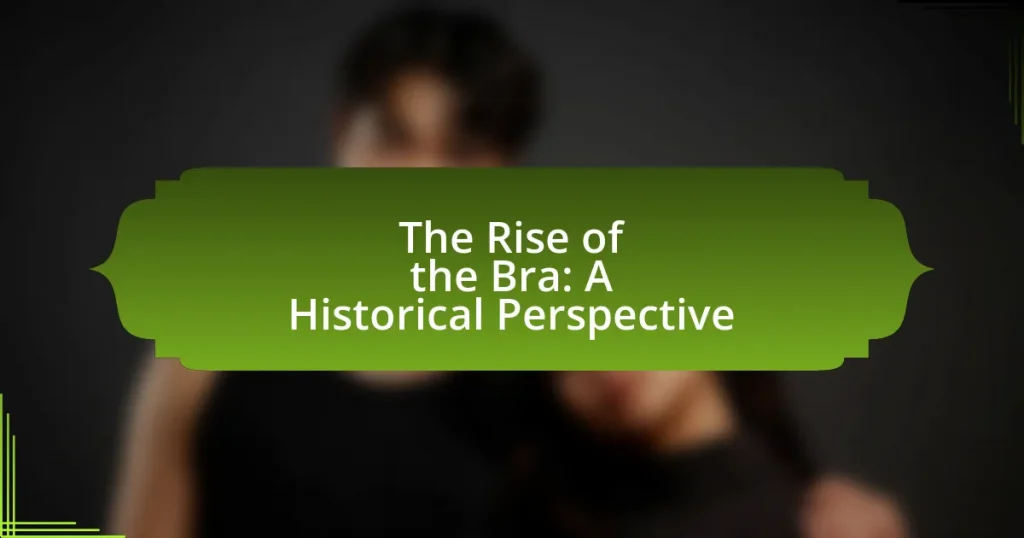The article examines the evolution of lingerie trends throughout the 20th century, highlighting the shift from functional undergarments to fashionable pieces. Key characteristics include the transition from corsets in the early 1900s to more relaxed silhouettes in the 1920s, the rise of the bra in the mid-century, and the influence of feminist movements on lingerie design and marketing. The discussion covers how societal changes, advancements in fabric technology, and major fashion movements shaped lingerie styles, ultimately establishing lingerie as a symbol of empowerment and personal expression. Additionally, the article explores the lasting effects of these trends on contemporary lingerie fashion, emphasizing comfort, inclusivity, and the integration of vintage styles into modern wardrobes.

What are the key characteristics of 20th century lingerie trends?
The key characteristics of 20th century lingerie trends include the evolution from functional undergarments to fashion-forward pieces, marked by significant changes in materials, styles, and societal perceptions. In the early 1900s, lingerie primarily served practical purposes, with corsets dominating women’s undergarments, emphasizing an hourglass figure. By the 1920s, the introduction of lighter fabrics like silk and rayon, along with the flapper movement, led to the popularity of more relaxed silhouettes such as camisoles and slips. The mid-century saw the rise of the bra as a staple, with innovations like the padded and push-up bras emerging in the 1950s, reflecting changing beauty standards. The late 20th century embraced bold designs, including lace and vibrant colors, influenced by the feminist movement, which encouraged women to express their individuality through lingerie. This transition highlights how lingerie became not only a functional item but also a significant aspect of personal style and empowerment.
How did lingerie evolve from functionality to fashion?
Lingerie evolved from functionality to fashion primarily due to changing societal norms and advancements in textile technology. In the early 20th century, lingerie served practical purposes, such as support and modesty, with garments like corsets and petticoats dominating women’s undergarments. However, the introduction of lighter, more flexible materials, along with the feminist movements advocating for women’s liberation, shifted the perception of lingerie towards a symbol of empowerment and self-expression. By the 1920s, the flapper era embraced more revealing styles, leading to the popularity of bras and slips designed not only for utility but also for aesthetic appeal. This transition was further solidified in the mid-20th century as lingerie became a key component of fashion shows and advertising, emphasizing allure and femininity, thus establishing lingerie as a fashionable item rather than merely functional wear.
What were the primary functional aspects of early 20th century lingerie?
The primary functional aspects of early 20th century lingerie included support, shaping, and modesty. Support was provided through structured garments like corsets, which were designed to shape the waist and lift the bust, reflecting the fashion ideals of the time. Shaping was achieved with the use of various materials, such as boning and padding, to create a desired silhouette that complemented outerwear styles. Modesty was also a key function, as lingerie served to cover the body in a socially acceptable manner, often featuring high necklines and longer hemlines in line with contemporary standards of decency. These functional aspects were essential in meeting the societal expectations of femininity and propriety during this period.
How did societal changes influence lingerie design?
Societal changes significantly influenced lingerie design by shifting the focus from functionality to fashion, reflecting evolving gender roles and cultural attitudes. For instance, the women’s liberation movement in the 1960s challenged traditional views on femininity, leading to the introduction of more diverse and expressive lingerie styles that emphasized comfort and personal choice over restrictive designs. Additionally, the rise of body positivity in the late 20th century encouraged brands to create lingerie that catered to a wider range of body types, promoting inclusivity and self-acceptance. These societal shifts resulted in lingerie becoming not just an undergarment but a statement of identity and empowerment, as evidenced by the increasing popularity of brands that prioritize both aesthetics and comfort in their designs.
What role did major fashion movements play in lingerie trends?
Major fashion movements significantly influenced lingerie trends by shifting perceptions from purely functional garments to stylish and expressive pieces. For instance, the flapper movement of the 1920s introduced a more liberated silhouette, leading to the popularization of shorter, less restrictive undergarments that emphasized comfort and freedom of movement. Similarly, the rise of the feminist movement in the 1960s and 1970s challenged traditional notions of femininity, resulting in the embrace of diverse styles, including the bralette and boyshorts, which prioritized both comfort and self-expression. These shifts reflect broader societal changes, as lingerie evolved to mirror the changing roles and identities of women throughout the 20th century.
How did the flapper movement impact lingerie styles?
The flapper movement significantly transformed lingerie styles by promoting a shift from restrictive garments to more liberating designs. This cultural change in the 1920s emphasized women’s independence and a desire for comfort, leading to the popularity of lighter, less structured lingerie such as camisoles and boyshorts. The introduction of new materials like silk and rayon allowed for more fluid silhouettes, aligning with the flapper’s iconic boyish figure. Additionally, the flapper’s rejection of corsets in favor of bras and slips marked a pivotal moment in lingerie history, reflecting broader societal changes regarding women’s roles and fashion preferences during this era.
What influence did World War II have on lingerie production and design?
World War II significantly influenced lingerie production and design by shifting focus from elaborate styles to practicality and functionality. During the war, fabric shortages and rationing led manufacturers to prioritize simpler designs that used less material, resulting in the introduction of more utilitarian styles such as the bralette and girdle. Additionally, the wartime need for women to enter the workforce prompted a change in lingerie to accommodate active lifestyles, leading to the adoption of more comfortable and supportive undergarments. This transition laid the groundwork for post-war lingerie trends that combined both functionality and fashion, reflecting the evolving roles of women in society.
What innovations emerged in lingerie materials and technology?
Innovations in lingerie materials and technology include the introduction of synthetic fabrics such as nylon, spandex, and polyester, which revolutionized comfort and fit. These materials, developed in the mid-20th century, allowed for greater elasticity and durability compared to traditional fabrics like cotton and silk. Additionally, advancements in seamless construction techniques and the use of laser cutting have enabled lingerie to be more form-fitting and less visible under clothing. The incorporation of moisture-wicking and breathable fabrics has also enhanced wearability, catering to modern consumers’ demands for both functionality and style.
How did advancements in fabric technology change lingerie design?
Advancements in fabric technology significantly transformed lingerie design by enabling the creation of lighter, more comfortable, and aesthetically appealing garments. Innovations such as the introduction of nylon in the 1930s allowed for seamless construction and a more form-fitting silhouette, which replaced the heavier materials previously used. Additionally, the development of stretch fabrics in the late 20th century provided greater flexibility and support, allowing for diverse styles that catered to various body types. These technological improvements not only enhanced the functionality of lingerie but also facilitated intricate designs and embellishments, aligning with evolving fashion trends and consumer preferences.
What new styles and silhouettes were introduced in the mid-20th century?
In the mid-20th century, new styles and silhouettes such as the bullet bra, the girdle, and the chemise were introduced, reflecting a shift towards more structured and form-fitting lingerie. The bullet bra, popularized in the 1940s and 1950s, created a pointed silhouette that emphasized the bust, aligning with the era’s fashion trends. Girdles became essential for shaping the waist and hips, providing a smooth line under clothing, while the chemise offered a more relaxed fit that catered to comfort without sacrificing style. These innovations marked a significant transition in lingerie design, moving from purely functional garments to those that also prioritized aesthetics and body shaping.

How did cultural shifts affect lingerie trends throughout the century?
Cultural shifts significantly influenced lingerie trends throughout the century by transforming perceptions of femininity and body image. For instance, the women’s liberation movement in the 1960s led to a rejection of restrictive garments, resulting in the popularity of more comfortable and practical styles like the bralette and boyshorts. Additionally, the rise of body positivity in the 1990s and 2000s encouraged diverse representations of body types, prompting brands to offer a wider range of sizes and styles that celebrate individuality. These shifts reflect broader societal changes, such as increased gender equality and evolving beauty standards, which have continuously shaped lingerie design and marketing strategies.
What impact did feminism have on lingerie perceptions?
Feminism significantly transformed perceptions of lingerie by challenging traditional views of women’s bodies and promoting empowerment through choice. The feminist movements of the 1960s and 1970s advocated for women’s autonomy, leading to a shift from lingerie being seen solely as a tool for male pleasure to an expression of personal identity and comfort. This change was exemplified by the rejection of restrictive garments, such as corsets, in favor of designs that prioritized comfort and self-expression, reflecting broader societal changes regarding women’s rights and roles. The introduction of diverse styles and sizes in lingerie also emerged from feminist advocacy for body positivity, allowing women to embrace their bodies in ways that align with their individual preferences rather than societal expectations.
How did the women’s liberation movement influence lingerie choices?
The women’s liberation movement significantly influenced lingerie choices by promoting comfort, practicality, and body positivity over traditional, restrictive designs. As women sought greater freedom and equality in the 1960s and 1970s, they began to reject the constraints of corsets and heavily structured bras, favoring styles that allowed for more natural body shapes and movements. This shift was reflected in the rise of lingerie brands that emphasized soft fabrics, minimalistic designs, and inclusivity, such as the introduction of bralettes and sports bras. The movement also encouraged women to embrace their bodies, leading to a broader acceptance of diverse body types in lingerie advertising and design, which was a departure from the idealized images of femininity that had dominated prior decades.
What changes occurred in marketing and advertising of lingerie?
The marketing and advertising of lingerie shifted significantly from a focus on functionality to an emphasis on fashion and empowerment. In the early 20th century, lingerie was primarily marketed for its practical benefits, such as support and modesty. However, by the mid to late 20th century, brands began to portray lingerie as a symbol of femininity, allure, and personal expression. This transition was marked by the rise of iconic advertising campaigns, such as Victoria’s Secret’s fashion shows, which showcased lingerie as a glamorous lifestyle choice rather than merely an undergarment. Additionally, the use of diverse models and body positivity in recent campaigns reflects a broader cultural shift towards inclusivity and self-acceptance, further transforming the lingerie marketing landscape.
How did celebrity culture shape lingerie fashion?
Celebrity culture significantly shaped lingerie fashion by popularizing it as a symbol of empowerment and sensuality. Icons like Marilyn Monroe and later, celebrities such as Madonna and Beyoncé, showcased lingerie not just as undergarments but as fashion statements, influencing public perception and desirability. This shift led to the rise of brands like Victoria’s Secret, which capitalized on celebrity endorsements and fashion shows to elevate lingerie into a mainstream fashion category. The visibility of lingerie in media and red carpet events further normalized its role in everyday fashion, making it a staple in women’s wardrobes.
Which iconic figures influenced lingerie trends in the 20th century?
Iconic figures who influenced lingerie trends in the 20th century include Marilyn Monroe, Coco Chanel, and Madonna. Marilyn Monroe popularized the hourglass figure and the use of sexy, form-fitting lingerie in the 1950s, which emphasized femininity and allure. Coco Chanel revolutionized women’s fashion by introducing more comfortable and practical lingerie, moving away from restrictive corsets in the 1920s. Madonna, in the 1980s, challenged traditional norms by incorporating lingerie into mainstream fashion, often wearing it as outerwear, which significantly impacted the perception of lingerie as a fashion statement.
How did media representation of lingerie evolve over the decades?
Media representation of lingerie evolved significantly from the 1920s to the 2020s, transitioning from a focus on functionality to an emphasis on fashion and empowerment. In the early decades, lingerie was primarily depicted in advertisements as practical undergarments, often associated with modesty and support, reflecting societal norms of femininity. By the 1960s and 1970s, the portrayal shifted towards a more liberated and sensual image, influenced by the feminist movement and changing attitudes towards women’s sexuality. The introduction of iconic brands and fashion shows in the 1980s and 1990s further transformed lingerie into a fashion statement, showcasing elaborate designs and luxurious materials. In recent years, media representation has embraced diversity and body positivity, highlighting a broader range of sizes and styles, thus reinforcing lingerie as a symbol of self-expression and confidence. This evolution is evidenced by the rise of inclusive marketing campaigns and the popularity of lingerie brands that celebrate individuality, such as Savage X Fenty, which launched in 2018 and emphasizes inclusivity in its advertising.

What are the lasting effects of 20th century lingerie trends on modern fashion?
The lasting effects of 20th century lingerie trends on modern fashion include the integration of lingerie as outerwear and the emphasis on comfort and body positivity. In the 1920s, the introduction of the flapper style led to the popularization of bras and girdles that prioritized a more liberated silhouette, influencing contemporary designs that often feature lingerie-inspired elements like bralettes and corsets worn as tops. Additionally, the 1960s and 1970s saw the rise of the feminist movement, which encouraged the rejection of restrictive undergarments, paving the way for modern brands that focus on inclusivity and comfort, such as ThirdLove and Aerie. These historical shifts have established a foundation for current fashion trends that celebrate both style and the wearer’s comfort, reflecting a significant evolution from purely functional undergarments to fashionable statements.
How do contemporary lingerie styles reflect historical trends?
Contemporary lingerie styles reflect historical trends by incorporating elements from past designs while adapting to modern aesthetics and societal norms. For instance, the shift from corsets in the early 20th century, which emphasized a structured silhouette, to the more relaxed and comfortable bralettes and wireless bras today illustrates this evolution. Additionally, the resurgence of vintage-inspired pieces, such as high-waisted panties and lace details, showcases how current fashion draws inspiration from the 1920s to the 1960s, periods known for their distinctive lingerie styles. This blend of historical influence and contemporary design is evident in brands that celebrate retro styles while ensuring comfort and inclusivity, aligning with current consumer preferences for both functionality and fashion.
What elements of vintage lingerie are still popular today?
Elements of vintage lingerie that remain popular today include lace detailing, high-waisted silhouettes, and the use of soft, luxurious fabrics. Lace has been a staple in lingerie design since the early 20th century, adding a romantic and feminine touch that continues to appeal to modern consumers. High-waisted panties, which gained popularity in the 1940s and 1950s, have made a resurgence as a fashionable choice that offers both comfort and style. Additionally, fabrics such as silk and satin, which were commonly used in vintage lingerie, are still favored for their softness and elegance, reflecting a timeless aesthetic that resonates with contemporary fashion trends.
How has the perception of lingerie as both functional and fashionable changed?
The perception of lingerie has evolved significantly from being solely functional to embracing a fashionable identity. In the early 20th century, lingerie primarily served practical purposes, focusing on support and modesty, as seen in the widespread use of corsets and bloomers. However, by the mid-20th century, societal shifts, including the feminist movement and changing beauty standards, began to influence lingerie design, leading to an emphasis on aesthetics and self-expression. The introduction of materials like lace and silk, along with innovative designs, transformed lingerie into a fashion statement, as evidenced by brands like Victoria’s Secret, which popularized the idea of lingerie as an essential part of a woman’s wardrobe. This shift reflects broader cultural changes, where lingerie is now viewed as both an intimate necessity and a means of empowerment, allowing individuals to express their personal style.
What are the best practices for selecting lingerie inspired by 20th century trends?
To select lingerie inspired by 20th century trends, prioritize understanding the historical context and key styles of each decade. For instance, the 1920s favored flapper styles with boyish silhouettes, while the 1950s emphasized hourglass shapes with structured corsetry. Consider fabric choices that reflect the era, such as silk and lace for the 1930s or nylon and spandex for the 1960s. Additionally, pay attention to color palettes; pastel shades were popular in the 1950s, while bold prints emerged in the 1970s. Finally, ensure the fit aligns with the intended style, as 20th century lingerie often combined functionality with fashion, making comfort and aesthetics equally important.
How can one incorporate vintage styles into a modern wardrobe?
To incorporate vintage styles into a modern wardrobe, one can blend classic pieces with contemporary items for a balanced look. For example, pairing a vintage lace camisole with high-waisted jeans creates a stylish contrast between eras. Additionally, incorporating accessories like vintage brooches or handbags can enhance modern outfits while adding a nostalgic touch. Historical fashion trends, such as the resurgence of 1940s silhouettes or 1970s prints, can be integrated into current styles, reflecting the cyclical nature of fashion. This approach not only honors past aesthetics but also allows for personal expression in a modern context.
What tips are there for choosing lingerie that balances comfort and style?
To choose lingerie that balances comfort and style, prioritize fit and fabric. A well-fitting piece enhances comfort and supports the body, while fabrics like cotton and modal provide breathability and softness. Additionally, consider styles that flatter your body shape, such as bras with adjustable straps for a customizable fit. Research indicates that 80% of women wear the wrong bra size, which can lead to discomfort; thus, proper sizing is crucial. Lastly, select designs that reflect personal style, as confidence in appearance contributes to overall comfort.



